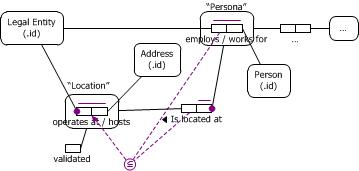I read Section 10.1 again and saw diagrams 10.4(a) and 10.5(a). I think I understand the idea captured in these diagrams now. The highlighting was very helpful in explaining the concepts. I also did not realize that it made sense to connect either end of the subset constraint to multiple roles at the same time. Again, the highlighting in the figures helped me get that idea.
The first diagrams I just made up on the spot, so they aren't particularly rigorous nor do they reflect real situations I am trying to model. No worries there.
I did try to apply the subset constraint to the second diagram (which is from an actual diagram). I ended up with the attached diagram. Regarding the subset constraint, I like the origination at the Legal Entity's Role in "Legal Entity employs Person". I also like the origination at Location in "Persona is located at Location". Location, however, is really "Legal Entity operates at Address", which seems a little odd. Ending the subset on "Legal Entity operates at Address", then gives this attempt at a reading:
"If a Legal Entity employs a Person as Persona, and that Persona is located at a Location, then that Legal Entity must operate at an Address as that Location."
Here I have used the phrase "as" to substitute the objectified relationship's reading. Is there another convention for that?
Incidentally, I did recast "Legal Entity employs Person" to "Legal Entity employs Person at Location", but I didn't like the implications of that formulation. Right now I show that Persona has exactly one Location, but that may be relaxed in the future to be optional (working with the business on that).
